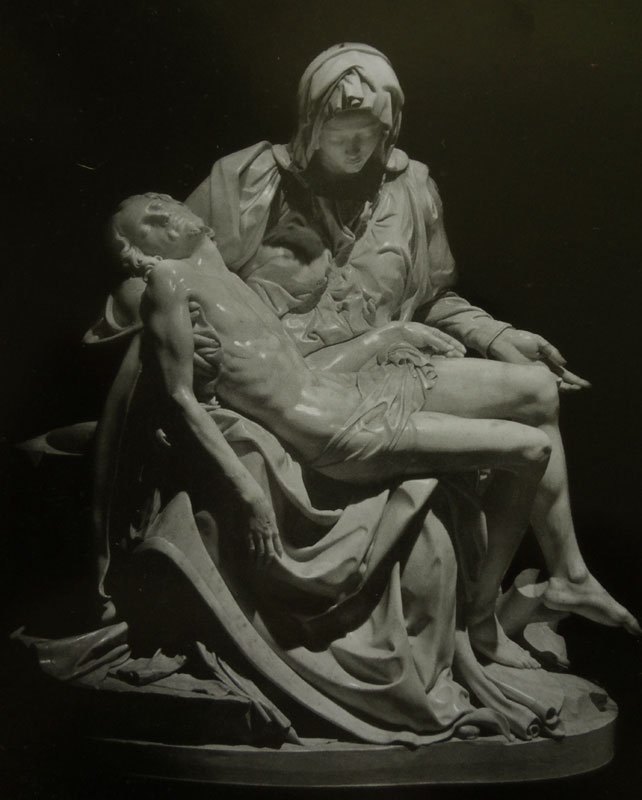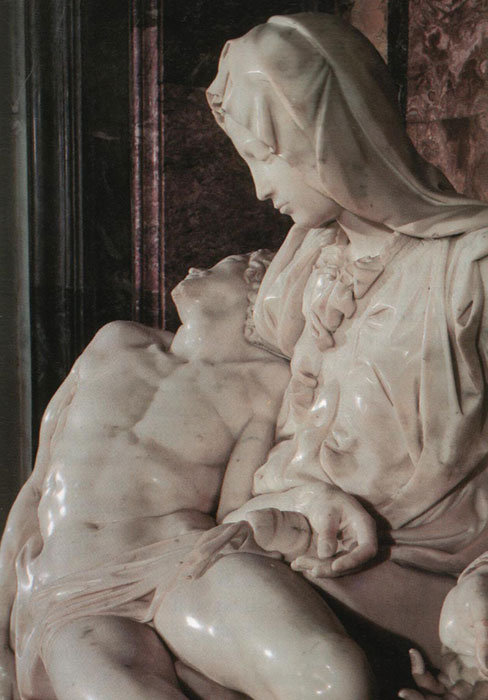Michelangelo in

Pieta, marble, 1499,
Cornelius Sullivan-Rome
There is one place on earth where you can be within a few steps of the ultimate masterpieces in sculpture, painting, and architecture done by the same artist. You would be standing under the dome of Peters Basilica in
He signed his letters “Michelangelo, Sculptor”. His way of seeing and uncovering form in a Neo Platonic way in a block of marble enabled him to paint figures that are three dimensional and to design architecture that commands space. He spent most of his life in
The young sculptor came to
Art Historian William Wallace names four Michelangelo works as cultural icons; The Rome Pieta, the Sistine Fresco Paintings, Moses, and David. The David is in

Saint Peters Basilica, view from the rear.
Michelangelo’s dome is the grandchild of the Pantheon dome in Rome. The Renaissance began in 1402 with the competition for the sculpture for the bronze doors of the Baptistry in
Brunelecschi returned and said, never mind the dirt, “I think I know how to do it.” He did. Michelangelo said that he was privileged to grow up under the shadow of the magnificent dome. His dome for
As an old man he volunteered to be the architect for Saint Peters Basilica for “the glory of God”, serving without pay until his death. He saw the drum for the dome before he died but not the dome itself. He took away fussy crenellations from previous architects and clarified and kept Bramante’s Greek cross design. The central pilasters became massive supports for the great dome.
This photograph shows the dome from the back and it also shows the muscularity of Michelangelo’s architecture. I call attention to it because he was a sculptor of muscular bodies first and foremost and that informed his work in all mediums. After his death the basilica became a Latin cross design with the long nave to accommodate more pilgrims. Some lament the fact that, as you approach the church, the dome is obscured by the massive façade. From any where else in the city, the dome dominates the skyline.
Sistine Chapel Fresco Paintings
There is no need for me to describe the fresco paintings because they are so well known. I can repeat what I have often told my students. The sculptor did not want to do the commission. There was some intrigue. Bramante, the architect for the basilica at the time, had the ear of Pope Julius. He said get Michelangelo to do the ceiling of that chapel, that odd shaped impossible space, (so that my home town boy, Raphael, can have the good job painting in your palace). To get out of the bad job the sculptor claimed to not know fresco. The shrewd pope said, oh no, we know you apprenticed with Gerlandaio in
Michelangelo began painting the twelve apostles. It was not going well. The good thing was he could be out of there in six months. But he could not do something not worthy of his great gifts. He destroyed what was done and ran off to the marble quarries in the mountains of
The
Michelangelo was twenty five when he finished carving his Pieta. The Sistine frescoes were from his middle years. Four years for the ceiling, and then many popes later he did the Last Judgement.
The Pieta is something good from a good job. The contract for the young man with the French Cardinal guarantied that it would be the best marble in
Low or high the sculpture is good from any angle and people still gasp when they first see it, even from far away behind bullet proof glass.
